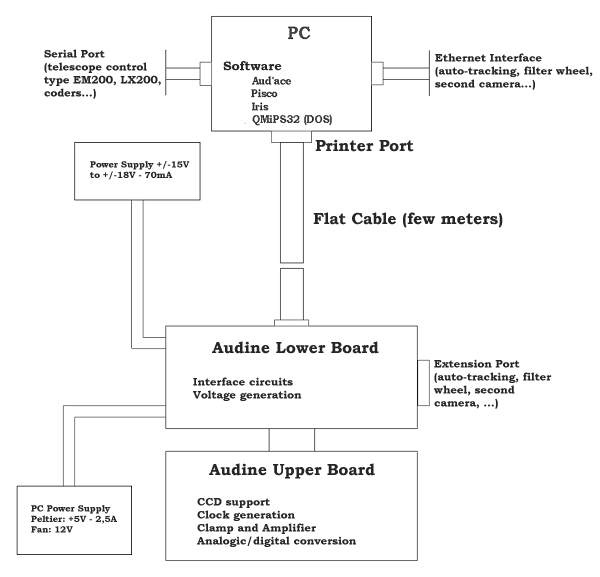
The AUDE association finds the fact that many amateur astronomers cannot utilize this technology - in particular young people who are just begining in this field - counterproductive and regretable. We think that a CCD camera kit is an exceptional teaching tool that facilitates the introduction of the amateur astronomer to multiple disciplines. Moreover, we have found that the people who build their own CCD cameras are those who learn the techniques and technology best. Finally, we hope that a dynamic environment will be created between the current users and future users that will facilitate the exchange of information and mutual aid. All the technical principles, diagrams, procedures of assembly and development, as well as the software that has been developed are made public and is completely free if you do not trade with it. Our project is now your project as well.
Many amateurs have encouraged us, but this enthusiasm also worried us: would the AUDE Association be able to face the demand if the project becomes successful ? We believe that the AUDE Association cannot ensure the diffusion of a CCD camera for general use into astronomy. That is not our goal - our objective is to provide the details of a maximum number of elements of the Audine camera and where they can be found in the shops. We want the cost of this project to remain as low as possible.
The Audine camera is a rectangular box with sides equal to 80 X 80 mm (3.15 in. X 3.15 in.), the height is 90 mm (3.54 in.) and it weighs 600 grams (~1.32 lbs.). The CCD sensor is the Kodak KAF-0400 which has 768x512 square pixels of 9 microns. A system with a Peltier module cools the sensor. The readout noise is lower than 18 electrons. The digitization of the image is of 15 bits and the reading time is approximately 15 seconds for full resolution. The camera is connected to an IBM-PC compatible computer via the printer port. It is also perfectly possible to use Audine with a portable computer.
Currently, the camera does not have a shutter. Although this is normally not
a problem, imaging of very bright objects such as the moon or sun without a
shutter may damage the instrument. For all other astronomical objects, effective
solutions are explained in this documentation.
The figure below shows a diagram of the Audine system:

Currently, only PISCO and AUDACE can be downloaded from this site. The electronic part of the camera is on two printed circuits. The lower card comprises connectors (DB25 for the connection with the PC and DB15 for the power supply) as well as the circuits for the interface and the power supply. The higher card is comprised of the CCD, the configuration circuits for the clocks, the amplification circuits, and the analog-to-digital conversion circuits.
For more information on the operation of a CCD, click here.
|
|
|
|